HRM and Corporate Strategy: Influencing Factors & Employment Relations
VerifiedAdded on 2023/05/28
|12
|4141
|390
Essay
AI Summary
This essay examines the role of Human Resource Management (HRM) in achieving a competitive edge within a dynamic corporate environment. It highlights the importance of aligning HRM practices with strategic objectives, focusing on how effective HRM policies contribute to improved performance and long-term sustainability. The essay uses FedEx as a case study, illustrating how their 'People-Services-Profits' approach fosters a positive organizational culture and drives competitive advantage. Furthermore, it discusses the impact of globalization and external factors, such as Brexit, on HRM policies and practices in the UK, emphasizing the need for HR to adapt to evolving legal and political landscapes. The essay concludes by stressing the significance of strategic HRM in attracting, training, and retaining skilled employees to achieve organizational goals.

Running Head: HR 0
HR
HR
Paraphrase This Document
Need a fresh take? Get an instant paraphrase of this document with our AI Paraphraser

HR 1
TASK 1
In any organization, Human resource management plays a significant role in helping business
and gaining a competitive edge in the dynamic and varying corporate environment (Chen and
Huang, 2009). With this globalised business world, an industry or business enterprise needs
to incorporate effective HRM practices both in internal and external environment for the
benefit of shareholders, company, employee and customers. These effective HRM practices
and plans also aid in improving the performance level to its maximum.
The human resource policies also contribute to linking the human resource functions with
strategic objective of the organization (Lengnick-Hall, Beck and Lengnick-Hall, 2011).
Therefore, it can be said that this holds the central live blood role in any company. In
addition, every organization intends to have edge over its rivalries for the long-term
sustainability (D'Aveni, Dagnino and Smith, 2010). Existing research suggests that
organizations find it extremely challenging to recruit, motivate, develop and retain competent
workforce in this fiercely competitive environment. There are various reasons behind these
challenging issues such as different employee culture and beliefs, global practices in an
organization, lucrative offer from the competitor company, performance assessment, and
many more.
Development of effective human resource policy also requires association on strategy
between HR and the enterprise leadership as the human capital are the main factor of any
business success (Guest, 2011). Thus, HR management programmes play a vital role in
sustaining a viable business. One of the fundamental aspects in creation of HR management
policies is strategic development. HRM policies and programmes make up a large portion of
the back end of an organization. HR policies help in communicating, developing, and
implementing a set of practices and policies that imitate a standard of satisfactory
performance (Aycan, Al-Hamadi, Davis and Budhwar, 2007). Moreover, a successful HRM
policy with effective strategy does more than drawing the restrictions; it identifies and
addresses individual requirements. This will help the organization to coordinate both specific
and organization goals. The main core principle that helps the organization in gaining
competitive advantage here is the performance improvement. It is related to setting up
various prospects and meeting them effectively. The main objective and focus of a business is
not only to achieve their specific goals but also considering the way to achieve them.
TASK 1
In any organization, Human resource management plays a significant role in helping business
and gaining a competitive edge in the dynamic and varying corporate environment (Chen and
Huang, 2009). With this globalised business world, an industry or business enterprise needs
to incorporate effective HRM practices both in internal and external environment for the
benefit of shareholders, company, employee and customers. These effective HRM practices
and plans also aid in improving the performance level to its maximum.
The human resource policies also contribute to linking the human resource functions with
strategic objective of the organization (Lengnick-Hall, Beck and Lengnick-Hall, 2011).
Therefore, it can be said that this holds the central live blood role in any company. In
addition, every organization intends to have edge over its rivalries for the long-term
sustainability (D'Aveni, Dagnino and Smith, 2010). Existing research suggests that
organizations find it extremely challenging to recruit, motivate, develop and retain competent
workforce in this fiercely competitive environment. There are various reasons behind these
challenging issues such as different employee culture and beliefs, global practices in an
organization, lucrative offer from the competitor company, performance assessment, and
many more.
Development of effective human resource policy also requires association on strategy
between HR and the enterprise leadership as the human capital are the main factor of any
business success (Guest, 2011). Thus, HR management programmes play a vital role in
sustaining a viable business. One of the fundamental aspects in creation of HR management
policies is strategic development. HRM policies and programmes make up a large portion of
the back end of an organization. HR policies help in communicating, developing, and
implementing a set of practices and policies that imitate a standard of satisfactory
performance (Aycan, Al-Hamadi, Davis and Budhwar, 2007). Moreover, a successful HRM
policy with effective strategy does more than drawing the restrictions; it identifies and
addresses individual requirements. This will help the organization to coordinate both specific
and organization goals. The main core principle that helps the organization in gaining
competitive advantage here is the performance improvement. It is related to setting up
various prospects and meeting them effectively. The main objective and focus of a business is
not only to achieve their specific goals but also considering the way to achieve them.

HR 2
HRM policies make sure that personnel have clear expectations and this can be addressed by
the four key elements i.e. – roles, rules, consequences and tools (Van den Brink, Fruytier and
Thunnissen, 2013). All employees working in an organization must know their respective
roles in addition with the reporting structure within the business enterprise. This approach
also signifies company-wide interdepartmental structures. In terms of rules, employees and
managers need to share mutual understanding in relation to acceptable behaviour within the
organization. Having a clear set of behavioural expectations is very important for the
organization in order to deliver strategic effect. Next thing is the consequences that is related
with violations of individual behavioural standards. Gaining of competitive edge in the
industry is also connected with the working of individuals together on the organisation floor
(Dave and Koskela, 2009). Practices and policies help in the interactions of employee while
reducing the personnel obstacles arise in the organizations. The last aspect is the tools, which
address the question how organization help the people and managed employee behaviour.
These tools plays a crucial role not just to help but also avoid litigation. It also minimizes the
time of the organization dealing with the productivity-draining employees’ concerns instead
of primary business matters.
Whatsoever the approaches adopted by the company, the fundamental aspect to success is to
integrate the resources and time it takes to build a plans and practices for the company before
any necessity. It is an essential component of HRM policies and comprehensive people
strategy (Christensen Hughes and Rog, 2008). The other significant part is that HRM
procedures will not only help the organization by supporting various aspects but also help in
creating the required organization culture. For instances, the management can add hiring and
retention strategies for delivering the value where employees are allowed for flexible
workforce, compensation policies and many pay options and many more. These are only
some of the benefits that an organization can use to maintain a positive culture in the internal
environment.
It can be easily understood by taking example of a company known as FedEx, an American
multinational courier practising a business of overnight shipping services. The company have
a pioneering system that helps them in tracking of packages and delivering of real-time
updates in relation with the location of packaging. The company deals with strategic HRM
principles rather than HRM and thus recognise the core strength of the organization in align
with the external aspects. This represents a competitive advantage for the company.
HRM policies make sure that personnel have clear expectations and this can be addressed by
the four key elements i.e. – roles, rules, consequences and tools (Van den Brink, Fruytier and
Thunnissen, 2013). All employees working in an organization must know their respective
roles in addition with the reporting structure within the business enterprise. This approach
also signifies company-wide interdepartmental structures. In terms of rules, employees and
managers need to share mutual understanding in relation to acceptable behaviour within the
organization. Having a clear set of behavioural expectations is very important for the
organization in order to deliver strategic effect. Next thing is the consequences that is related
with violations of individual behavioural standards. Gaining of competitive edge in the
industry is also connected with the working of individuals together on the organisation floor
(Dave and Koskela, 2009). Practices and policies help in the interactions of employee while
reducing the personnel obstacles arise in the organizations. The last aspect is the tools, which
address the question how organization help the people and managed employee behaviour.
These tools plays a crucial role not just to help but also avoid litigation. It also minimizes the
time of the organization dealing with the productivity-draining employees’ concerns instead
of primary business matters.
Whatsoever the approaches adopted by the company, the fundamental aspect to success is to
integrate the resources and time it takes to build a plans and practices for the company before
any necessity. It is an essential component of HRM policies and comprehensive people
strategy (Christensen Hughes and Rog, 2008). The other significant part is that HRM
procedures will not only help the organization by supporting various aspects but also help in
creating the required organization culture. For instances, the management can add hiring and
retention strategies for delivering the value where employees are allowed for flexible
workforce, compensation policies and many pay options and many more. These are only
some of the benefits that an organization can use to maintain a positive culture in the internal
environment.
It can be easily understood by taking example of a company known as FedEx, an American
multinational courier practising a business of overnight shipping services. The company have
a pioneering system that helps them in tracking of packages and delivering of real-time
updates in relation with the location of packaging. The company deals with strategic HRM
principles rather than HRM and thus recognise the core strength of the organization in align
with the external aspects. This represents a competitive advantage for the company.
⊘ This is a preview!⊘
Do you want full access?
Subscribe today to unlock all pages.

Trusted by 1+ million students worldwide
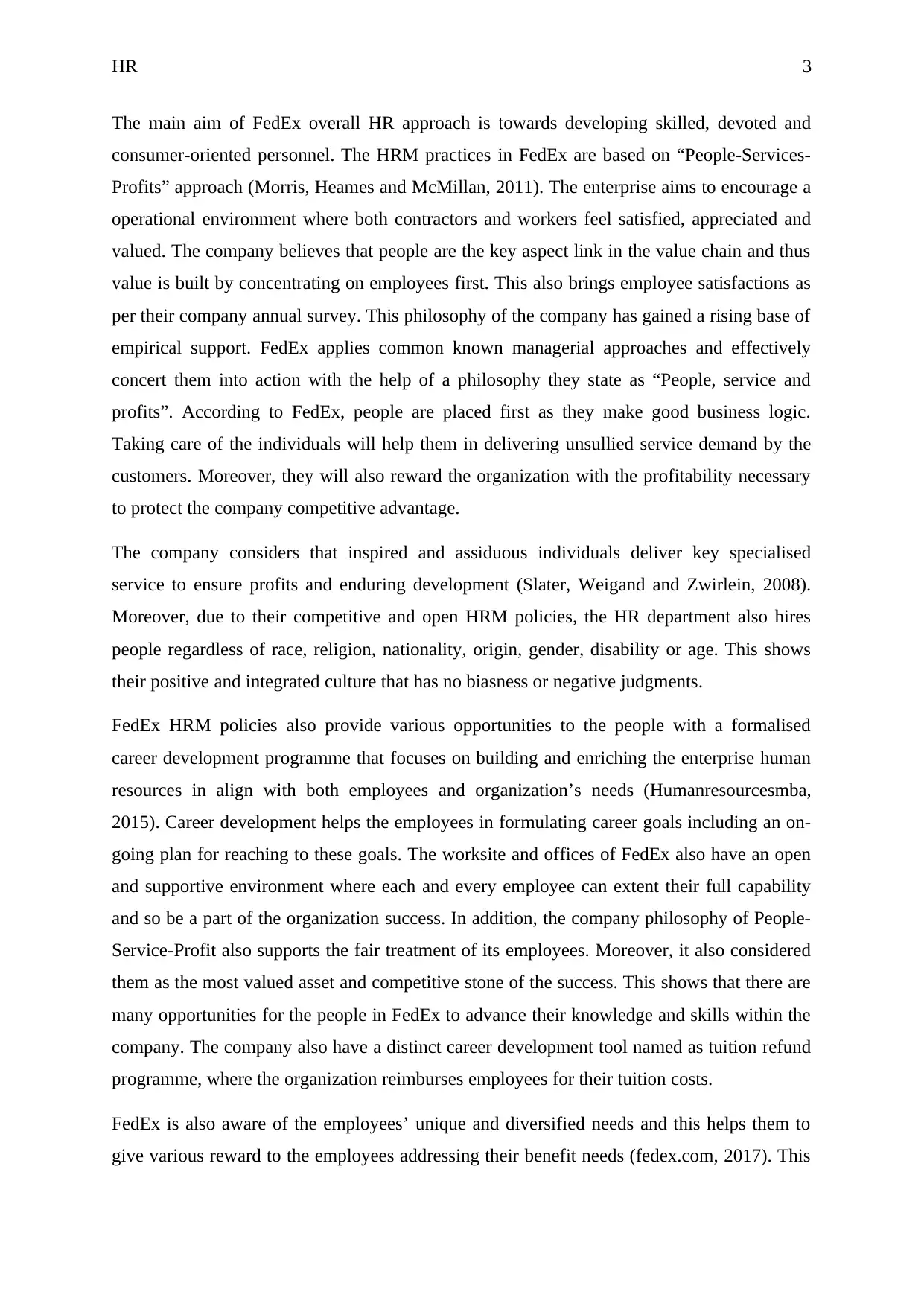
HR 3
The main aim of FedEx overall HR approach is towards developing skilled, devoted and
consumer-oriented personnel. The HRM practices in FedEx are based on “People-Services-
Profits” approach (Morris, Heames and McMillan, 2011). The enterprise aims to encourage a
operational environment where both contractors and workers feel satisfied, appreciated and
valued. The company believes that people are the key aspect link in the value chain and thus
value is built by concentrating on employees first. This also brings employee satisfactions as
per their company annual survey. This philosophy of the company has gained a rising base of
empirical support. FedEx applies common known managerial approaches and effectively
concert them into action with the help of a philosophy they state as “People, service and
profits”. According to FedEx, people are placed first as they make good business logic.
Taking care of the individuals will help them in delivering unsullied service demand by the
customers. Moreover, they will also reward the organization with the profitability necessary
to protect the company competitive advantage.
The company considers that inspired and assiduous individuals deliver key specialised
service to ensure profits and enduring development (Slater, Weigand and Zwirlein, 2008).
Moreover, due to their competitive and open HRM policies, the HR department also hires
people regardless of race, religion, nationality, origin, gender, disability or age. This shows
their positive and integrated culture that has no biasness or negative judgments.
FedEx HRM policies also provide various opportunities to the people with a formalised
career development programme that focuses on building and enriching the enterprise human
resources in align with both employees and organization’s needs (Humanresourcesmba,
2015). Career development helps the employees in formulating career goals including an on-
going plan for reaching to these goals. The worksite and offices of FedEx also have an open
and supportive environment where each and every employee can extent their full capability
and so be a part of the organization success. In addition, the company philosophy of People-
Service-Profit also supports the fair treatment of its employees. Moreover, it also considered
them as the most valued asset and competitive stone of the success. This shows that there are
many opportunities for the people in FedEx to advance their knowledge and skills within the
company. The company also have a distinct career development tool named as tuition refund
programme, where the organization reimburses employees for their tuition costs.
FedEx is also aware of the employees’ unique and diversified needs and this helps them to
give various reward to the employees addressing their benefit needs (fedex.com, 2017). This
The main aim of FedEx overall HR approach is towards developing skilled, devoted and
consumer-oriented personnel. The HRM practices in FedEx are based on “People-Services-
Profits” approach (Morris, Heames and McMillan, 2011). The enterprise aims to encourage a
operational environment where both contractors and workers feel satisfied, appreciated and
valued. The company believes that people are the key aspect link in the value chain and thus
value is built by concentrating on employees first. This also brings employee satisfactions as
per their company annual survey. This philosophy of the company has gained a rising base of
empirical support. FedEx applies common known managerial approaches and effectively
concert them into action with the help of a philosophy they state as “People, service and
profits”. According to FedEx, people are placed first as they make good business logic.
Taking care of the individuals will help them in delivering unsullied service demand by the
customers. Moreover, they will also reward the organization with the profitability necessary
to protect the company competitive advantage.
The company considers that inspired and assiduous individuals deliver key specialised
service to ensure profits and enduring development (Slater, Weigand and Zwirlein, 2008).
Moreover, due to their competitive and open HRM policies, the HR department also hires
people regardless of race, religion, nationality, origin, gender, disability or age. This shows
their positive and integrated culture that has no biasness or negative judgments.
FedEx HRM policies also provide various opportunities to the people with a formalised
career development programme that focuses on building and enriching the enterprise human
resources in align with both employees and organization’s needs (Humanresourcesmba,
2015). Career development helps the employees in formulating career goals including an on-
going plan for reaching to these goals. The worksite and offices of FedEx also have an open
and supportive environment where each and every employee can extent their full capability
and so be a part of the organization success. In addition, the company philosophy of People-
Service-Profit also supports the fair treatment of its employees. Moreover, it also considered
them as the most valued asset and competitive stone of the success. This shows that there are
many opportunities for the people in FedEx to advance their knowledge and skills within the
company. The company also have a distinct career development tool named as tuition refund
programme, where the organization reimburses employees for their tuition costs.
FedEx is also aware of the employees’ unique and diversified needs and this helps them to
give various reward to the employees addressing their benefit needs (fedex.com, 2017). This
Paraphrase This Document
Need a fresh take? Get an instant paraphrase of this document with our AI Paraphraser
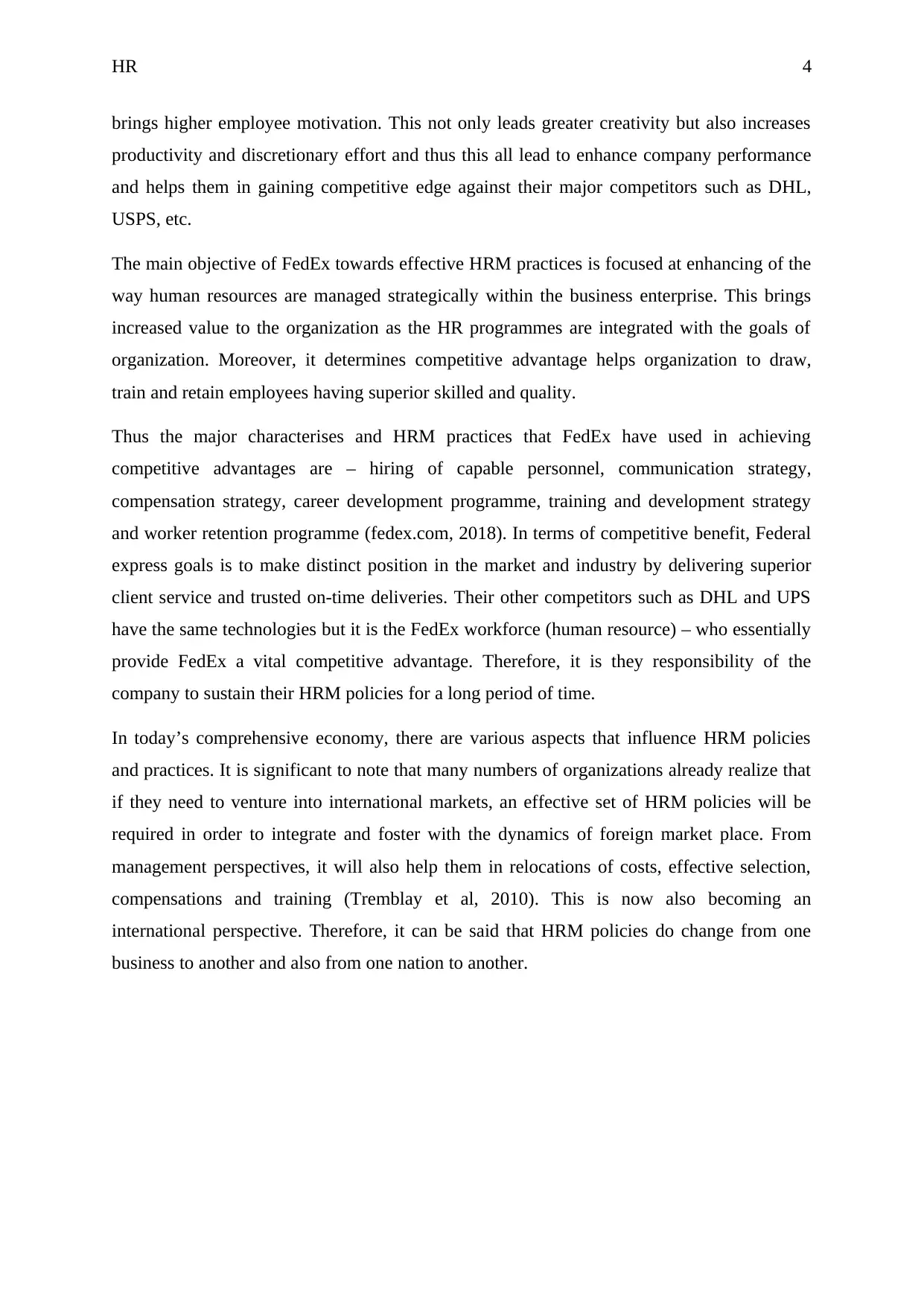
HR 4
brings higher employee motivation. This not only leads greater creativity but also increases
productivity and discretionary effort and thus this all lead to enhance company performance
and helps them in gaining competitive edge against their major competitors such as DHL,
USPS, etc.
The main objective of FedEx towards effective HRM practices is focused at enhancing of the
way human resources are managed strategically within the business enterprise. This brings
increased value to the organization as the HR programmes are integrated with the goals of
organization. Moreover, it determines competitive advantage helps organization to draw,
train and retain employees having superior skilled and quality.
Thus the major characterises and HRM practices that FedEx have used in achieving
competitive advantages are – hiring of capable personnel, communication strategy,
compensation strategy, career development programme, training and development strategy
and worker retention programme (fedex.com, 2018). In terms of competitive benefit, Federal
express goals is to make distinct position in the market and industry by delivering superior
client service and trusted on-time deliveries. Their other competitors such as DHL and UPS
have the same technologies but it is the FedEx workforce (human resource) – who essentially
provide FedEx a vital competitive advantage. Therefore, it is they responsibility of the
company to sustain their HRM policies for a long period of time.
In today’s comprehensive economy, there are various aspects that influence HRM policies
and practices. It is significant to note that many numbers of organizations already realize that
if they need to venture into international markets, an effective set of HRM policies will be
required in order to integrate and foster with the dynamics of foreign market place. From
management perspectives, it will also help them in relocations of costs, effective selection,
compensations and training (Tremblay et al, 2010). This is now also becoming an
international perspective. Therefore, it can be said that HRM policies do change from one
business to another and also from one nation to another.
brings higher employee motivation. This not only leads greater creativity but also increases
productivity and discretionary effort and thus this all lead to enhance company performance
and helps them in gaining competitive edge against their major competitors such as DHL,
USPS, etc.
The main objective of FedEx towards effective HRM practices is focused at enhancing of the
way human resources are managed strategically within the business enterprise. This brings
increased value to the organization as the HR programmes are integrated with the goals of
organization. Moreover, it determines competitive advantage helps organization to draw,
train and retain employees having superior skilled and quality.
Thus the major characterises and HRM practices that FedEx have used in achieving
competitive advantages are – hiring of capable personnel, communication strategy,
compensation strategy, career development programme, training and development strategy
and worker retention programme (fedex.com, 2018). In terms of competitive benefit, Federal
express goals is to make distinct position in the market and industry by delivering superior
client service and trusted on-time deliveries. Their other competitors such as DHL and UPS
have the same technologies but it is the FedEx workforce (human resource) – who essentially
provide FedEx a vital competitive advantage. Therefore, it is they responsibility of the
company to sustain their HRM policies for a long period of time.
In today’s comprehensive economy, there are various aspects that influence HRM policies
and practices. It is significant to note that many numbers of organizations already realize that
if they need to venture into international markets, an effective set of HRM policies will be
required in order to integrate and foster with the dynamics of foreign market place. From
management perspectives, it will also help them in relocations of costs, effective selection,
compensations and training (Tremblay et al, 2010). This is now also becoming an
international perspective. Therefore, it can be said that HRM policies do change from one
business to another and also from one nation to another.
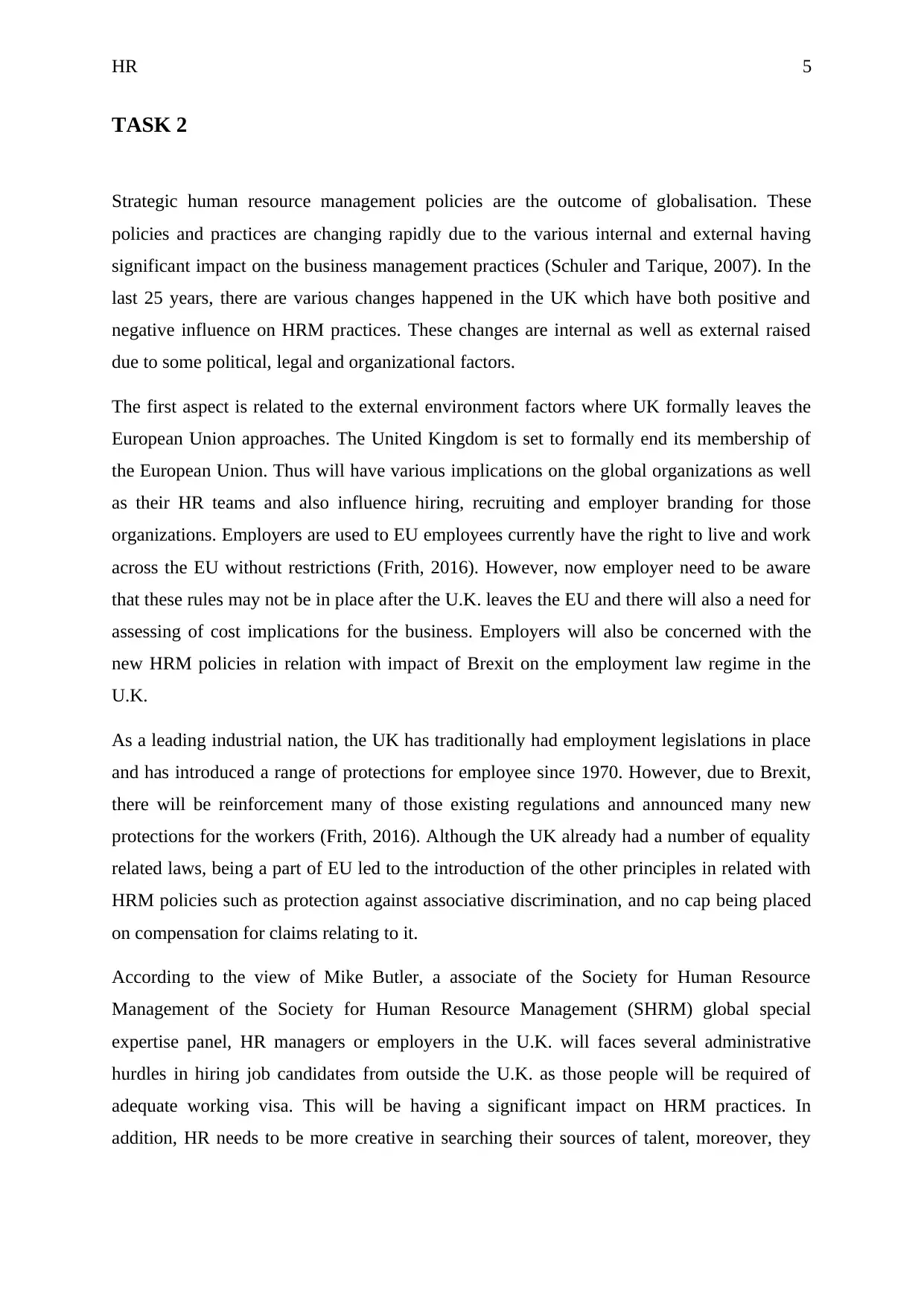
HR 5
TASK 2
Strategic human resource management policies are the outcome of globalisation. These
policies and practices are changing rapidly due to the various internal and external having
significant impact on the business management practices (Schuler and Tarique, 2007). In the
last 25 years, there are various changes happened in the UK which have both positive and
negative influence on HRM practices. These changes are internal as well as external raised
due to some political, legal and organizational factors.
The first aspect is related to the external environment factors where UK formally leaves the
European Union approaches. The United Kingdom is set to formally end its membership of
the European Union. Thus will have various implications on the global organizations as well
as their HR teams and also influence hiring, recruiting and employer branding for those
organizations. Employers are used to EU employees currently have the right to live and work
across the EU without restrictions (Frith, 2016). However, now employer need to be aware
that these rules may not be in place after the U.K. leaves the EU and there will also a need for
assessing of cost implications for the business. Employers will also be concerned with the
new HRM policies in relation with impact of Brexit on the employment law regime in the
U.K.
As a leading industrial nation, the UK has traditionally had employment legislations in place
and has introduced a range of protections for employee since 1970. However, due to Brexit,
there will be reinforcement many of those existing regulations and announced many new
protections for the workers (Frith, 2016). Although the UK already had a number of equality
related laws, being a part of EU led to the introduction of the other principles in related with
HRM policies such as protection against associative discrimination, and no cap being placed
on compensation for claims relating to it.
According to the view of Mike Butler, a associate of the Society for Human Resource
Management of the Society for Human Resource Management (SHRM) global special
expertise panel, HR managers or employers in the U.K. will faces several administrative
hurdles in hiring job candidates from outside the U.K. as those people will be required of
adequate working visa. This will be having a significant impact on HRM practices. In
addition, HR needs to be more creative in searching their sources of talent, moreover, they
TASK 2
Strategic human resource management policies are the outcome of globalisation. These
policies and practices are changing rapidly due to the various internal and external having
significant impact on the business management practices (Schuler and Tarique, 2007). In the
last 25 years, there are various changes happened in the UK which have both positive and
negative influence on HRM practices. These changes are internal as well as external raised
due to some political, legal and organizational factors.
The first aspect is related to the external environment factors where UK formally leaves the
European Union approaches. The United Kingdom is set to formally end its membership of
the European Union. Thus will have various implications on the global organizations as well
as their HR teams and also influence hiring, recruiting and employer branding for those
organizations. Employers are used to EU employees currently have the right to live and work
across the EU without restrictions (Frith, 2016). However, now employer need to be aware
that these rules may not be in place after the U.K. leaves the EU and there will also a need for
assessing of cost implications for the business. Employers will also be concerned with the
new HRM policies in relation with impact of Brexit on the employment law regime in the
U.K.
As a leading industrial nation, the UK has traditionally had employment legislations in place
and has introduced a range of protections for employee since 1970. However, due to Brexit,
there will be reinforcement many of those existing regulations and announced many new
protections for the workers (Frith, 2016). Although the UK already had a number of equality
related laws, being a part of EU led to the introduction of the other principles in related with
HRM policies such as protection against associative discrimination, and no cap being placed
on compensation for claims relating to it.
According to the view of Mike Butler, a associate of the Society for Human Resource
Management of the Society for Human Resource Management (SHRM) global special
expertise panel, HR managers or employers in the U.K. will faces several administrative
hurdles in hiring job candidates from outside the U.K. as those people will be required of
adequate working visa. This will be having a significant impact on HRM practices. In
addition, HR needs to be more creative in searching their sources of talent, moreover, they
⊘ This is a preview!⊘
Do you want full access?
Subscribe today to unlock all pages.

Trusted by 1+ million students worldwide
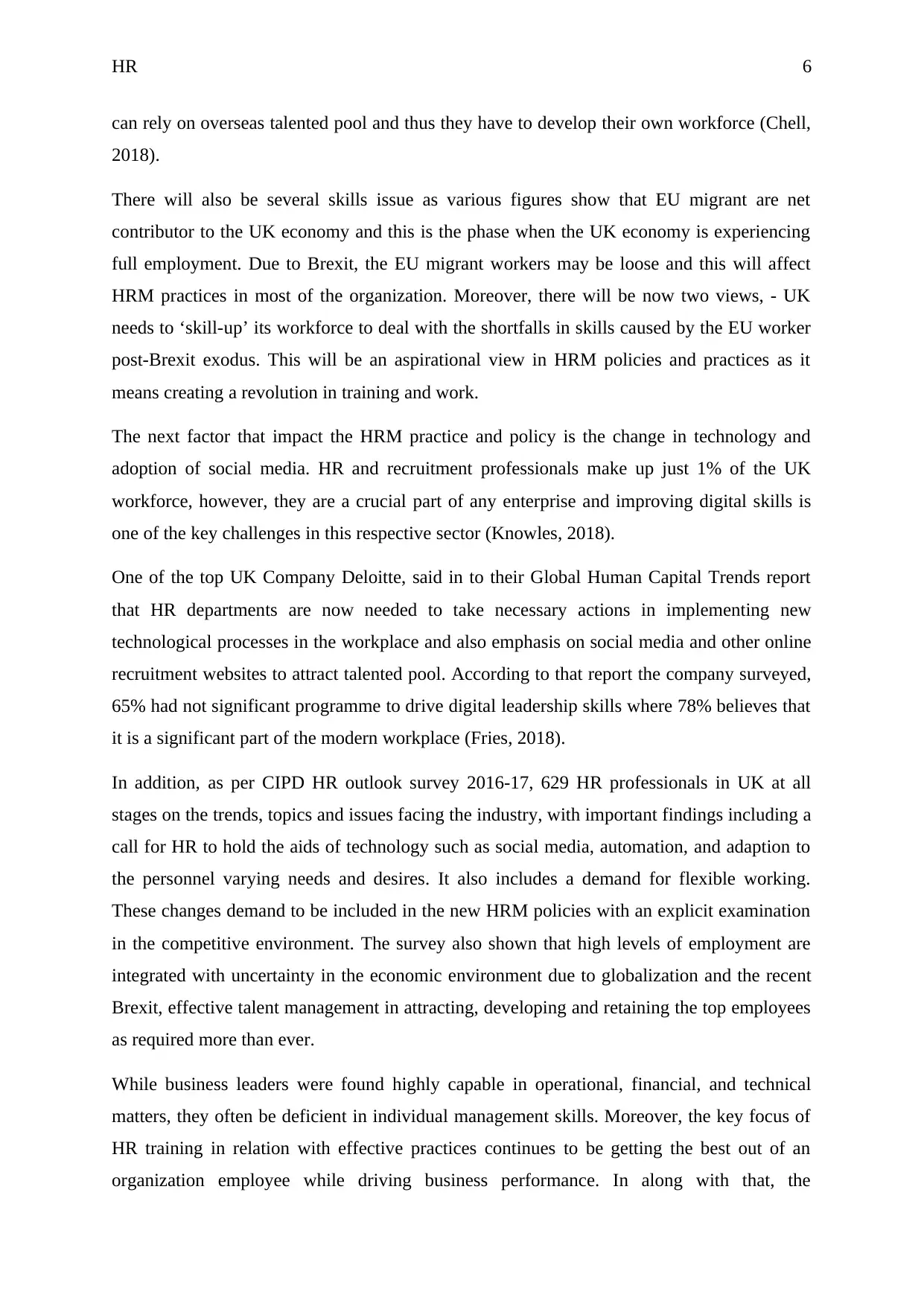
HR 6
can rely on overseas talented pool and thus they have to develop their own workforce (Chell,
2018).
There will also be several skills issue as various figures show that EU migrant are net
contributor to the UK economy and this is the phase when the UK economy is experiencing
full employment. Due to Brexit, the EU migrant workers may be loose and this will affect
HRM practices in most of the organization. Moreover, there will be now two views, - UK
needs to ‘skill-up’ its workforce to deal with the shortfalls in skills caused by the EU worker
post-Brexit exodus. This will be an aspirational view in HRM policies and practices as it
means creating a revolution in training and work.
The next factor that impact the HRM practice and policy is the change in technology and
adoption of social media. HR and recruitment professionals make up just 1% of the UK
workforce, however, they are a crucial part of any enterprise and improving digital skills is
one of the key challenges in this respective sector (Knowles, 2018).
One of the top UK Company Deloitte, said in to their Global Human Capital Trends report
that HR departments are now needed to take necessary actions in implementing new
technological processes in the workplace and also emphasis on social media and other online
recruitment websites to attract talented pool. According to that report the company surveyed,
65% had not significant programme to drive digital leadership skills where 78% believes that
it is a significant part of the modern workplace (Fries, 2018).
In addition, as per CIPD HR outlook survey 2016-17, 629 HR professionals in UK at all
stages on the trends, topics and issues facing the industry, with important findings including a
call for HR to hold the aids of technology such as social media, automation, and adaption to
the personnel varying needs and desires. It also includes a demand for flexible working.
These changes demand to be included in the new HRM policies with an explicit examination
in the competitive environment. The survey also shown that high levels of employment are
integrated with uncertainty in the economic environment due to globalization and the recent
Brexit, effective talent management in attracting, developing and retaining the top employees
as required more than ever.
While business leaders were found highly capable in operational, financial, and technical
matters, they often be deficient in individual management skills. Moreover, the key focus of
HR training in relation with effective practices continues to be getting the best out of an
organization employee while driving business performance. In along with that, the
can rely on overseas talented pool and thus they have to develop their own workforce (Chell,
2018).
There will also be several skills issue as various figures show that EU migrant are net
contributor to the UK economy and this is the phase when the UK economy is experiencing
full employment. Due to Brexit, the EU migrant workers may be loose and this will affect
HRM practices in most of the organization. Moreover, there will be now two views, - UK
needs to ‘skill-up’ its workforce to deal with the shortfalls in skills caused by the EU worker
post-Brexit exodus. This will be an aspirational view in HRM policies and practices as it
means creating a revolution in training and work.
The next factor that impact the HRM practice and policy is the change in technology and
adoption of social media. HR and recruitment professionals make up just 1% of the UK
workforce, however, they are a crucial part of any enterprise and improving digital skills is
one of the key challenges in this respective sector (Knowles, 2018).
One of the top UK Company Deloitte, said in to their Global Human Capital Trends report
that HR departments are now needed to take necessary actions in implementing new
technological processes in the workplace and also emphasis on social media and other online
recruitment websites to attract talented pool. According to that report the company surveyed,
65% had not significant programme to drive digital leadership skills where 78% believes that
it is a significant part of the modern workplace (Fries, 2018).
In addition, as per CIPD HR outlook survey 2016-17, 629 HR professionals in UK at all
stages on the trends, topics and issues facing the industry, with important findings including a
call for HR to hold the aids of technology such as social media, automation, and adaption to
the personnel varying needs and desires. It also includes a demand for flexible working.
These changes demand to be included in the new HRM policies with an explicit examination
in the competitive environment. The survey also shown that high levels of employment are
integrated with uncertainty in the economic environment due to globalization and the recent
Brexit, effective talent management in attracting, developing and retaining the top employees
as required more than ever.
While business leaders were found highly capable in operational, financial, and technical
matters, they often be deficient in individual management skills. Moreover, the key focus of
HR training in relation with effective practices continues to be getting the best out of an
organization employee while driving business performance. In along with that, the
Paraphrase This Document
Need a fresh take? Get an instant paraphrase of this document with our AI Paraphraser
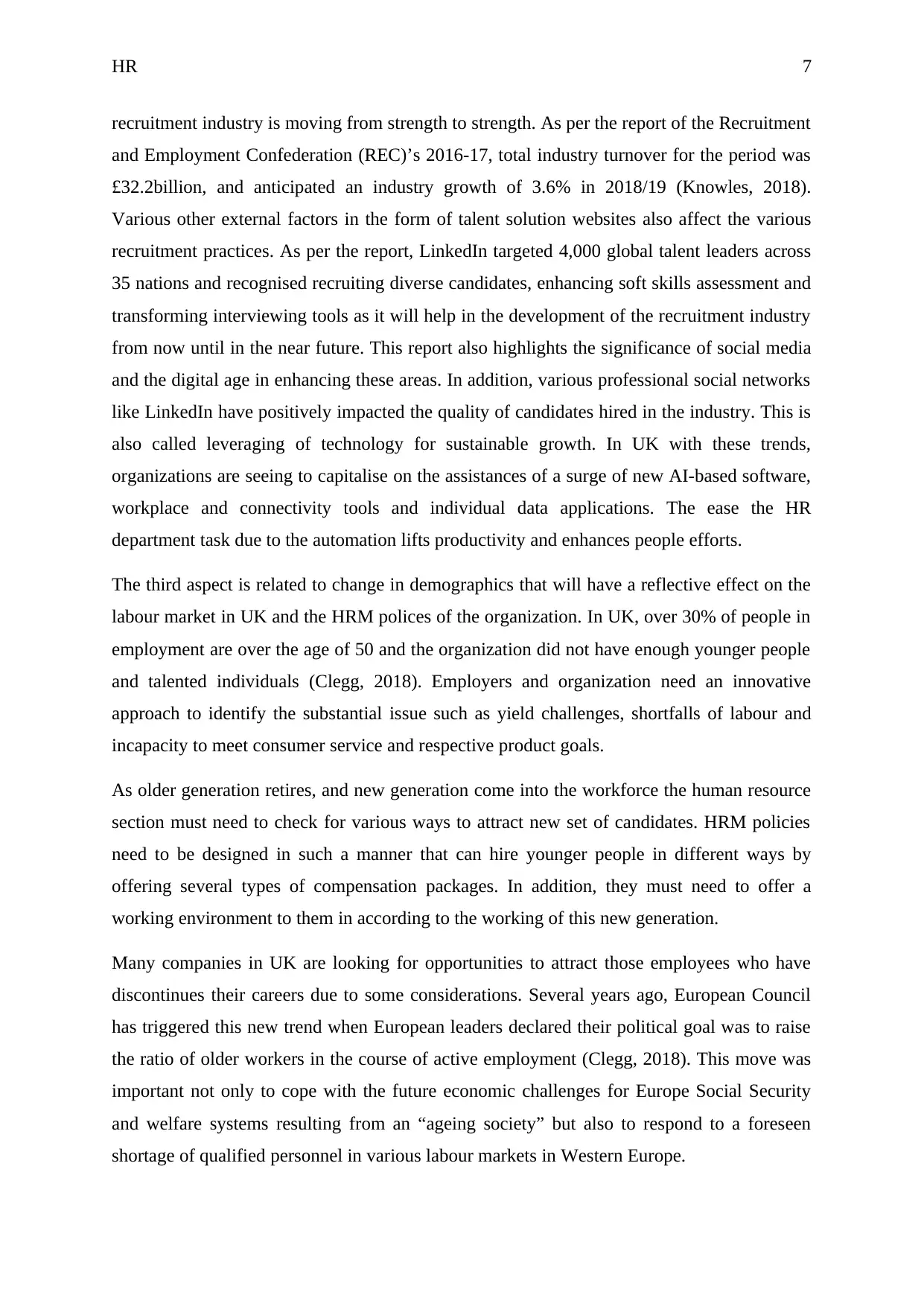
HR 7
recruitment industry is moving from strength to strength. As per the report of the Recruitment
and Employment Confederation (REC)’s 2016-17, total industry turnover for the period was
£32.2billion, and anticipated an industry growth of 3.6% in 2018/19 (Knowles, 2018).
Various other external factors in the form of talent solution websites also affect the various
recruitment practices. As per the report, LinkedIn targeted 4,000 global talent leaders across
35 nations and recognised recruiting diverse candidates, enhancing soft skills assessment and
transforming interviewing tools as it will help in the development of the recruitment industry
from now until in the near future. This report also highlights the significance of social media
and the digital age in enhancing these areas. In addition, various professional social networks
like LinkedIn have positively impacted the quality of candidates hired in the industry. This is
also called leveraging of technology for sustainable growth. In UK with these trends,
organizations are seeing to capitalise on the assistances of a surge of new AI-based software,
workplace and connectivity tools and individual data applications. The ease the HR
department task due to the automation lifts productivity and enhances people efforts.
The third aspect is related to change in demographics that will have a reflective effect on the
labour market in UK and the HRM polices of the organization. In UK, over 30% of people in
employment are over the age of 50 and the organization did not have enough younger people
and talented individuals (Clegg, 2018). Employers and organization need an innovative
approach to identify the substantial issue such as yield challenges, shortfalls of labour and
incapacity to meet consumer service and respective product goals.
As older generation retires, and new generation come into the workforce the human resource
section must need to check for various ways to attract new set of candidates. HRM policies
need to be designed in such a manner that can hire younger people in different ways by
offering several types of compensation packages. In addition, they must need to offer a
working environment to them in according to the working of this new generation.
Many companies in UK are looking for opportunities to attract those employees who have
discontinues their careers due to some considerations. Several years ago, European Council
has triggered this new trend when European leaders declared their political goal was to raise
the ratio of older workers in the course of active employment (Clegg, 2018). This move was
important not only to cope with the future economic challenges for Europe Social Security
and welfare systems resulting from an “ageing society” but also to respond to a foreseen
shortage of qualified personnel in various labour markets in Western Europe.
recruitment industry is moving from strength to strength. As per the report of the Recruitment
and Employment Confederation (REC)’s 2016-17, total industry turnover for the period was
£32.2billion, and anticipated an industry growth of 3.6% in 2018/19 (Knowles, 2018).
Various other external factors in the form of talent solution websites also affect the various
recruitment practices. As per the report, LinkedIn targeted 4,000 global talent leaders across
35 nations and recognised recruiting diverse candidates, enhancing soft skills assessment and
transforming interviewing tools as it will help in the development of the recruitment industry
from now until in the near future. This report also highlights the significance of social media
and the digital age in enhancing these areas. In addition, various professional social networks
like LinkedIn have positively impacted the quality of candidates hired in the industry. This is
also called leveraging of technology for sustainable growth. In UK with these trends,
organizations are seeing to capitalise on the assistances of a surge of new AI-based software,
workplace and connectivity tools and individual data applications. The ease the HR
department task due to the automation lifts productivity and enhances people efforts.
The third aspect is related to change in demographics that will have a reflective effect on the
labour market in UK and the HRM polices of the organization. In UK, over 30% of people in
employment are over the age of 50 and the organization did not have enough younger people
and talented individuals (Clegg, 2018). Employers and organization need an innovative
approach to identify the substantial issue such as yield challenges, shortfalls of labour and
incapacity to meet consumer service and respective product goals.
As older generation retires, and new generation come into the workforce the human resource
section must need to check for various ways to attract new set of candidates. HRM policies
need to be designed in such a manner that can hire younger people in different ways by
offering several types of compensation packages. In addition, they must need to offer a
working environment to them in according to the working of this new generation.
Many companies in UK are looking for opportunities to attract those employees who have
discontinues their careers due to some considerations. Several years ago, European Council
has triggered this new trend when European leaders declared their political goal was to raise
the ratio of older workers in the course of active employment (Clegg, 2018). This move was
important not only to cope with the future economic challenges for Europe Social Security
and welfare systems resulting from an “ageing society” but also to respond to a foreseen
shortage of qualified personnel in various labour markets in Western Europe.

HR 8
This all requires that organization need to contemplate what changes they need to be
introduced as the effect of having a more diversified workforce, in relation with employment
relationship as well in terms of age. Moreover, the HR department also needs to be highly
aware of the different requirements of the different stakeholder's groups and the capability to
solve substantial conflicts with the help of innovative solutions.
The necessary steps that need to be considered as a part of HR practices in light with the
changed structure and in terms of demographics, longer life expectancies, different working-
time rules, etc. Moreover, individual HR programmes also need to be revised in align with
revised HR strategies. The organizations that see various opportunities in diversifying their
workforce will deliver an extended career in relation with the new retirement ages. This will
help them to well cop up with the high demand of qualified candidates.
In terms of legal aspects, the General Equal Treatment Act also applies to organization
pension plans. This designed pension plan must comply with the new legal framework of UK
(Davis, 2018). The HR department planned these plans in particular employee entire career
and also financed by an organization. In addition, the Federal Labour Court provides some
guidance as to its existing stance on how to solve such issue.
This all requires that organization need to contemplate what changes they need to be
introduced as the effect of having a more diversified workforce, in relation with employment
relationship as well in terms of age. Moreover, the HR department also needs to be highly
aware of the different requirements of the different stakeholder's groups and the capability to
solve substantial conflicts with the help of innovative solutions.
The necessary steps that need to be considered as a part of HR practices in light with the
changed structure and in terms of demographics, longer life expectancies, different working-
time rules, etc. Moreover, individual HR programmes also need to be revised in align with
revised HR strategies. The organizations that see various opportunities in diversifying their
workforce will deliver an extended career in relation with the new retirement ages. This will
help them to well cop up with the high demand of qualified candidates.
In terms of legal aspects, the General Equal Treatment Act also applies to organization
pension plans. This designed pension plan must comply with the new legal framework of UK
(Davis, 2018). The HR department planned these plans in particular employee entire career
and also financed by an organization. In addition, the Federal Labour Court provides some
guidance as to its existing stance on how to solve such issue.
⊘ This is a preview!⊘
Do you want full access?
Subscribe today to unlock all pages.

Trusted by 1+ million students worldwide
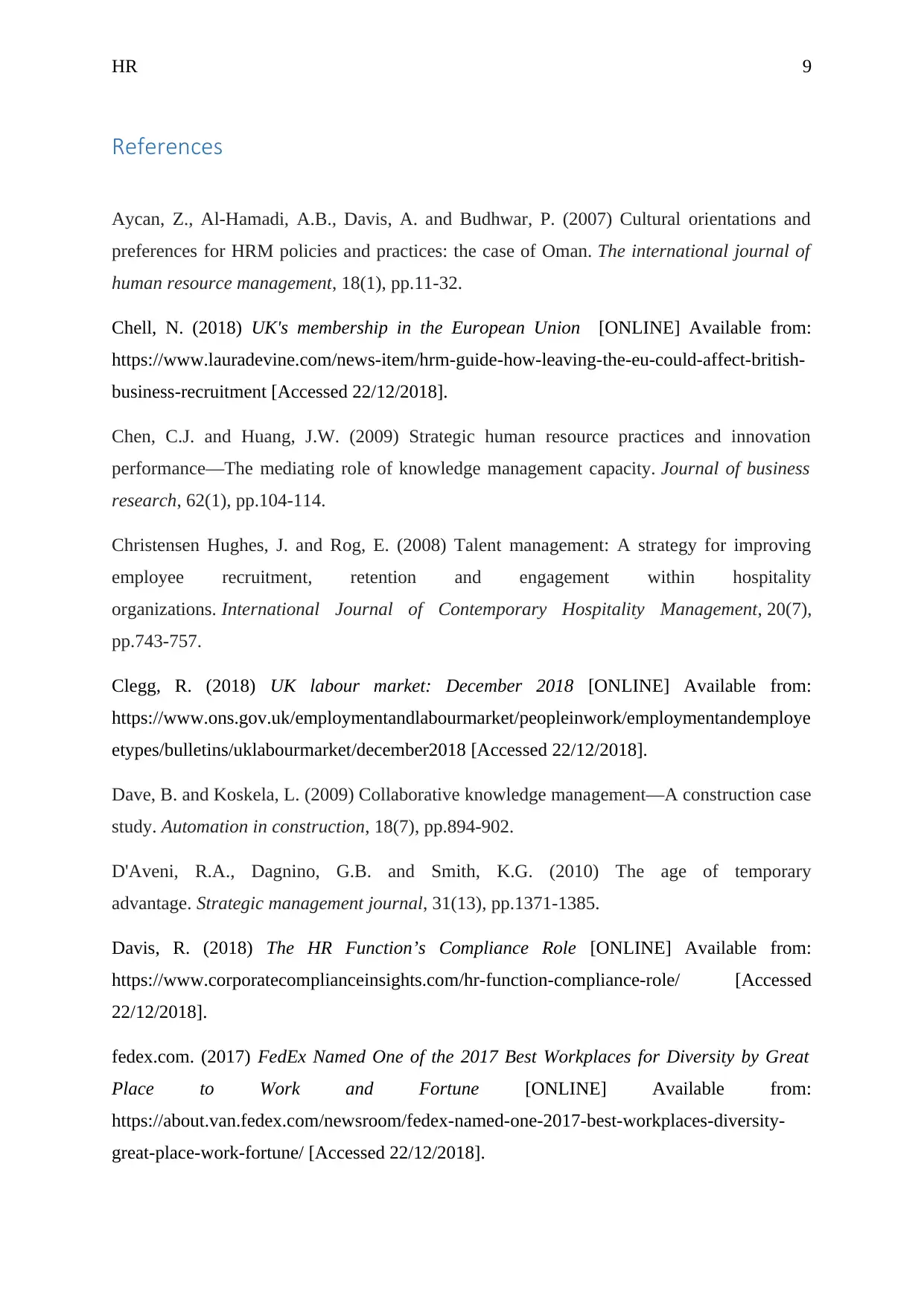
HR 9
References
Aycan, Z., Al-Hamadi, A.B., Davis, A. and Budhwar, P. (2007) Cultural orientations and
preferences for HRM policies and practices: the case of Oman. The international journal of
human resource management, 18(1), pp.11-32.
Chell, N. (2018) UK's membership in the European Union [ONLINE] Available from:
https://www.lauradevine.com/news-item/hrm-guide-how-leaving-the-eu-could-affect-british-
business-recruitment [Accessed 22/12/2018].
Chen, C.J. and Huang, J.W. (2009) Strategic human resource practices and innovation
performance—The mediating role of knowledge management capacity. Journal of business
research, 62(1), pp.104-114.
Christensen Hughes, J. and Rog, E. (2008) Talent management: A strategy for improving
employee recruitment, retention and engagement within hospitality
organizations. International Journal of Contemporary Hospitality Management, 20(7),
pp.743-757.
Clegg, R. (2018) UK labour market: December 2018 [ONLINE] Available from:
https://www.ons.gov.uk/employmentandlabourmarket/peopleinwork/employmentandemploye
etypes/bulletins/uklabourmarket/december2018 [Accessed 22/12/2018].
Dave, B. and Koskela, L. (2009) Collaborative knowledge management—A construction case
study. Automation in construction, 18(7), pp.894-902.
D'Aveni, R.A., Dagnino, G.B. and Smith, K.G. (2010) The age of temporary
advantage. Strategic management journal, 31(13), pp.1371-1385.
Davis, R. (2018) The HR Function’s Compliance Role [ONLINE] Available from:
https://www.corporatecomplianceinsights.com/hr-function-compliance-role/ [Accessed
22/12/2018].
fedex.com. (2017) FedEx Named One of the 2017 Best Workplaces for Diversity by Great
Place to Work and Fortune [ONLINE] Available from:
https://about.van.fedex.com/newsroom/fedex-named-one-2017-best-workplaces-diversity-
great-place-work-fortune/ [Accessed 22/12/2018].
References
Aycan, Z., Al-Hamadi, A.B., Davis, A. and Budhwar, P. (2007) Cultural orientations and
preferences for HRM policies and practices: the case of Oman. The international journal of
human resource management, 18(1), pp.11-32.
Chell, N. (2018) UK's membership in the European Union [ONLINE] Available from:
https://www.lauradevine.com/news-item/hrm-guide-how-leaving-the-eu-could-affect-british-
business-recruitment [Accessed 22/12/2018].
Chen, C.J. and Huang, J.W. (2009) Strategic human resource practices and innovation
performance—The mediating role of knowledge management capacity. Journal of business
research, 62(1), pp.104-114.
Christensen Hughes, J. and Rog, E. (2008) Talent management: A strategy for improving
employee recruitment, retention and engagement within hospitality
organizations. International Journal of Contemporary Hospitality Management, 20(7),
pp.743-757.
Clegg, R. (2018) UK labour market: December 2018 [ONLINE] Available from:
https://www.ons.gov.uk/employmentandlabourmarket/peopleinwork/employmentandemploye
etypes/bulletins/uklabourmarket/december2018 [Accessed 22/12/2018].
Dave, B. and Koskela, L. (2009) Collaborative knowledge management—A construction case
study. Automation in construction, 18(7), pp.894-902.
D'Aveni, R.A., Dagnino, G.B. and Smith, K.G. (2010) The age of temporary
advantage. Strategic management journal, 31(13), pp.1371-1385.
Davis, R. (2018) The HR Function’s Compliance Role [ONLINE] Available from:
https://www.corporatecomplianceinsights.com/hr-function-compliance-role/ [Accessed
22/12/2018].
fedex.com. (2017) FedEx Named One of the 2017 Best Workplaces for Diversity by Great
Place to Work and Fortune [ONLINE] Available from:
https://about.van.fedex.com/newsroom/fedex-named-one-2017-best-workplaces-diversity-
great-place-work-fortune/ [Accessed 22/12/2018].
Paraphrase This Document
Need a fresh take? Get an instant paraphrase of this document with our AI Paraphraser

HR 10
fedex.com. (2018) Overview of Company [ONLINE] Available from:
http://investors.fedex.com/company-overview/overview-of-company/default.aspx [Accessed
22/12/2018].
Fries, K. (2018) 7 Ways Millennials Are Changing Traditional Leadership [ONLINE]
Available from: https://www.forbes.com/sites/kimberlyfries/2018/01/18/7-ways-millennials-
are-changing-traditional-leadership/#8909b307dae6 [Accessed 22/12/2018].
Frith, B. (2016) What Brexit means for HR [ONLINE] Available from:
https://www.hrmagazine.co.uk/article-details/what-brexit-means-for-hr [Accessed
22/12/2018].
Guest, D.E. (2011) Human resource management and performance: still searching for some
answers. Human resource management journal, 21(1), pp.3-13.
Humanresourcesmba. (2015) The World’s 30 Most Innovative Corporate Human Resources
Departments [ONLINE] Available from: https://www.humanresourcesmba.net/worlds-30-
innovative-corporate-human-resources-departments/ [Accessed 22/12/2018].
Knowles, E. (2018) Overview of the UK's HR and recruitment industry [ONLINE] Available
from: https://www.prospects.ac.uk/jobs-and-work-experience/job-sectors/recruitment-and-
hr/overview-of-the-uks-hr-and-recruitment-industry [Accessed 22/12/2018].
Lengnick-Hall, C.A., Beck, T.E. and Lengnick-Hall, M.L. (2011) Developing a capacity for
organizational resilience through strategic human resource management. Human Resource
Management Review, 21(3), pp.243-255.
Morris, M.L., Heames, J.T. and McMillan, H.S. (2011) Human resource executives'
perceptions and measurement of the strategic impact of work/life initiatives. Human
Resource Development Quarterly, 22(3), pp.265-295.
Schuler, R.S. and Tarique, I. (2007) International human resource management: a North
American perspective, a thematic update and suggestions for future research. The
international journal of human resource management, 18(5), pp.717-744.
Slater, S.F., Weigand, R.A. and Zwirlein, T.J. (2008) The business case for commitment to
diversity. Business horizons, 51(3), pp.201-209.
Tremblay, M., Cloutier, J., Simard, G., Chênevert, D. and Vandenberghe, C. (2010) The role
of HRM practices, procedural justice, organizational support and trust in organizational
fedex.com. (2018) Overview of Company [ONLINE] Available from:
http://investors.fedex.com/company-overview/overview-of-company/default.aspx [Accessed
22/12/2018].
Fries, K. (2018) 7 Ways Millennials Are Changing Traditional Leadership [ONLINE]
Available from: https://www.forbes.com/sites/kimberlyfries/2018/01/18/7-ways-millennials-
are-changing-traditional-leadership/#8909b307dae6 [Accessed 22/12/2018].
Frith, B. (2016) What Brexit means for HR [ONLINE] Available from:
https://www.hrmagazine.co.uk/article-details/what-brexit-means-for-hr [Accessed
22/12/2018].
Guest, D.E. (2011) Human resource management and performance: still searching for some
answers. Human resource management journal, 21(1), pp.3-13.
Humanresourcesmba. (2015) The World’s 30 Most Innovative Corporate Human Resources
Departments [ONLINE] Available from: https://www.humanresourcesmba.net/worlds-30-
innovative-corporate-human-resources-departments/ [Accessed 22/12/2018].
Knowles, E. (2018) Overview of the UK's HR and recruitment industry [ONLINE] Available
from: https://www.prospects.ac.uk/jobs-and-work-experience/job-sectors/recruitment-and-
hr/overview-of-the-uks-hr-and-recruitment-industry [Accessed 22/12/2018].
Lengnick-Hall, C.A., Beck, T.E. and Lengnick-Hall, M.L. (2011) Developing a capacity for
organizational resilience through strategic human resource management. Human Resource
Management Review, 21(3), pp.243-255.
Morris, M.L., Heames, J.T. and McMillan, H.S. (2011) Human resource executives'
perceptions and measurement of the strategic impact of work/life initiatives. Human
Resource Development Quarterly, 22(3), pp.265-295.
Schuler, R.S. and Tarique, I. (2007) International human resource management: a North
American perspective, a thematic update and suggestions for future research. The
international journal of human resource management, 18(5), pp.717-744.
Slater, S.F., Weigand, R.A. and Zwirlein, T.J. (2008) The business case for commitment to
diversity. Business horizons, 51(3), pp.201-209.
Tremblay, M., Cloutier, J., Simard, G., Chênevert, D. and Vandenberghe, C. (2010) The role
of HRM practices, procedural justice, organizational support and trust in organizational
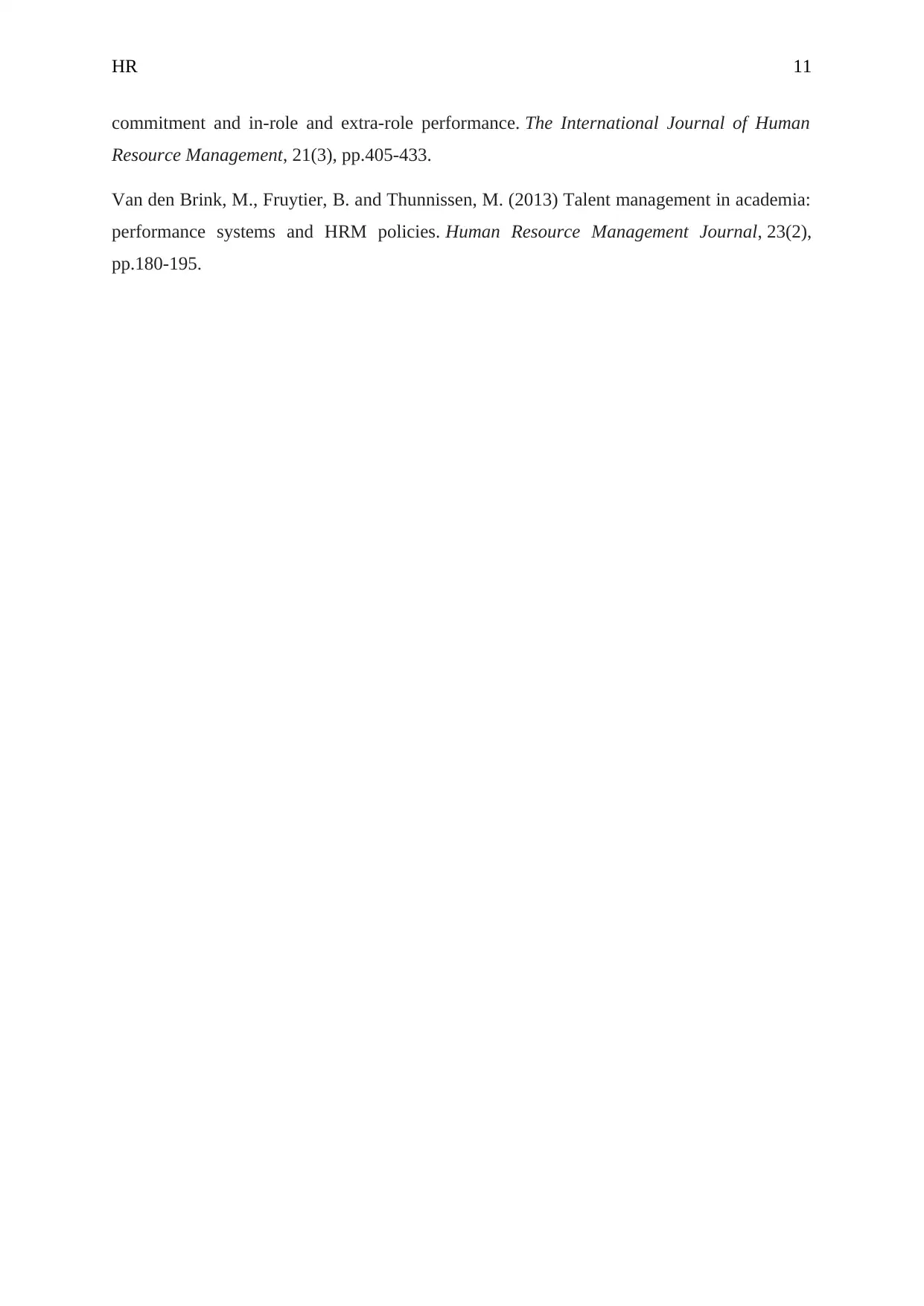
HR 11
commitment and in-role and extra-role performance. The International Journal of Human
Resource Management, 21(3), pp.405-433.
Van den Brink, M., Fruytier, B. and Thunnissen, M. (2013) Talent management in academia:
performance systems and HRM policies. Human Resource Management Journal, 23(2),
pp.180-195.
commitment and in-role and extra-role performance. The International Journal of Human
Resource Management, 21(3), pp.405-433.
Van den Brink, M., Fruytier, B. and Thunnissen, M. (2013) Talent management in academia:
performance systems and HRM policies. Human Resource Management Journal, 23(2),
pp.180-195.
⊘ This is a preview!⊘
Do you want full access?
Subscribe today to unlock all pages.

Trusted by 1+ million students worldwide
1 out of 12
Related Documents
Your All-in-One AI-Powered Toolkit for Academic Success.
+13062052269
info@desklib.com
Available 24*7 on WhatsApp / Email
![[object Object]](/_next/static/media/star-bottom.7253800d.svg)
Unlock your academic potential
Copyright © 2020–2025 A2Z Services. All Rights Reserved. Developed and managed by ZUCOL.





